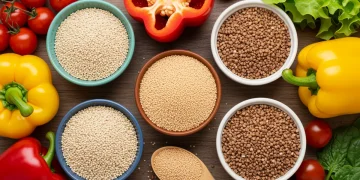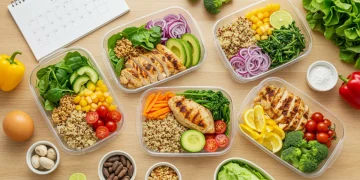2025 Guide: Sugar-Free Baking for Blood Sugar Control

This 2025 guide to sugar-free baking offers five delicious dessert recipes using natural sweeteners, designed to help you enjoy sweet treats without spiking your blood sugar, promoting a healthier lifestyle.
Welcome to The 2025 Guide to Sugar-Free Baking: 5 Delicious Dessert Recipes That Won’t Spike Your Blood Sugar, Featuring Natural Sweeteners. In an era where health and wellness take center stage, managing blood sugar levels has become a paramount concern for many. This guide delves into the exciting world of sugar-free baking, demonstrating that you don’t have to sacrifice taste for health. We’ll explore innovative approaches and natural sweeteners that make indulging in delightful desserts a guilt-free pleasure, without the dreaded blood sugar spikes.
The Rise of Sugar-Free Baking: Why Now?
The landscape of dietary health is constantly evolving, and 2025 marks a significant shift towards more conscious eating, particularly concerning sugar intake. Consumers are increasingly aware of the detrimental effects of excessive sugar on blood sugar levels, weight management, and overall well-being. This heightened awareness has fueled a demand for healthier alternatives, propelling sugar-free baking into the mainstream.
Beyond personal health goals, there’s a growing understanding of the environmental and ethical implications of food production, leading many to seek out ingredients that are both good for them and sustainable for the planet. This holistic approach to food choices is reshaping how we view and create our favorite sweet treats. The availability of diverse and high-quality natural sweeteners has also played a crucial role in making sugar-free baking not just a viable option, but a truly delicious one.
Understanding the Impact of Sugar on Blood Sugar
Traditional sugar, primarily sucrose, is a disaccharide rapidly broken down into glucose and fructose, leading to a quick rise in blood glucose. This immediate spike triggers the pancreas to release insulin, which helps transport glucose into cells for energy or storage. While this is a natural process, chronic overconsumption of sugar can lead to:
- Insulin resistance, a precursor to type 2 diabetes.
- Increased risk of cardiovascular diseases.
- Weight gain and obesity.
- Inflammation throughout the body.
Opting for sugar-free alternatives helps mitigate these risks by providing sweetness without the rapid glucose absorption. It allows for better blood sugar control, which is essential for individuals with diabetes or those looking to maintain stable energy levels throughout the day.
The movement towards sugar-free baking is more than just a trend; it’s a fundamental change in how we approach our diets, prioritizing long-term health benefits without compromising on the joy of eating delicious food. This guide aims to empower you with the knowledge and recipes to embrace this healthier way of life.
Navigating Natural Sweeteners: Your Guide to Healthier Choices
Choosing the right natural sweeteners is key to successful and healthy sugar-free baking. Not all sweeteners are created equal, and understanding their properties, glycemic index, and how they behave in recipes is crucial for achieving delicious results without compromising blood sugar control. The market for natural sweeteners has expanded significantly, offering a wide array of options that cater to different tastes and dietary needs.
These alternatives go beyond just reducing calories; many offer additional health benefits, such as antioxidants or fiber, and almost all have a lower glycemic impact than traditional sugar. Experimenting with different sweeteners can be an exciting journey, allowing you to discover new flavor profiles and textures in your baked goods.
Popular Natural Sweeteners and Their Baking Properties
- Erythritol: A sugar alcohol that is about 70% as sweet as sugar, with almost no calories and a glycemic index of zero. It bakes well, provides bulk, and doesn’t cause digestive upset for most people in moderate amounts.
- Stevia: Derived from the stevia plant, it’s incredibly sweet (200-400 times sweeter than sugar) and has a glycemic index of zero. It’s often used in combination with other sweeteners to improve texture.
- Monk Fruit Sweetener: Another zero-calorie, zero-glycemic index sweetener, monk fruit is 150-250 times sweeter than sugar. It’s stable at high temperatures and provides a clean taste, making it ideal for baking.
- Xylitol: A sugar alcohol with a similar sweetness and texture to sugar, but with fewer calories and a lower glycemic index (around 13). It’s important to note that xylitol is toxic to dogs.
- Allulose: A ‘rare sugar’ that tastes and functions much like regular sugar but has only 10% of the calories and a very low glycemic impact. It caramelizes and browns similarly to sugar, making it excellent for baking.
When substituting sugar with these alternatives, remember that some may be significantly sweeter than sugar, requiring smaller quantities. Always check the conversion ratios provided by the manufacturer or look for recipes specifically developed for the sweetener you are using. Combining different sweeteners can also yield a more balanced flavor and texture profile, mimicking sugar more closely.

The key to successful sugar-free baking lies in understanding how each sweetener interacts with other ingredients. Some provide bulk, others moisture, and some contribute to browning. With a bit of practice and experimentation, you’ll master the art of creating delicious baked goods that are both healthy and satisfying.
Essential Tips for Successful Sugar-Free Baking
Embarking on a sugar-free baking journey requires a slightly different approach than traditional baking. While the core principles remain the same, certain adjustments and considerations are necessary to achieve the best results. These tips will help you navigate the common challenges and ensure your sugar-free treats turn out perfectly every time.
From understanding ingredient substitutions to mastering baking temperatures, these insights are designed to empower you with the knowledge needed to confidently create delicious and healthy desserts. The goal is to make the transition to sugar-free baking as smooth and enjoyable as possible, yielding treats that are not only good for you but also taste incredible.
Mastering Textures and Flavors Without Sugar
Sugar contributes more than just sweetness; it also plays a vital role in the texture, moisture, and browning of baked goods. When removing sugar, you might notice your creations are less moist, don’t brown as much, or have a different crumb structure. Here are some strategies to counter these effects:
- Moisture Retention: Incorporate ingredients like unsweetened applesauce, mashed banana, pumpkin puree, or Greek yogurt to add moisture. Healthy fats such as avocado or coconut oil can also help.
- Browning: Some natural sweeteners, like allulose, brown better than others. For those that don’t, a light brushing of egg wash or a slightly higher baking temperature for a shorter duration can encourage browning.
- Texture: To achieve a tender crumb, ensure you don’t overmix the batter. Adding a touch of protein, like a scoop of collagen powder or egg whites, can also improve structure.
Another common challenge is the cooling effect some sugar alcohols can have. This can be mitigated by combining different sweeteners or by adding a pinch of salt or a touch of vanilla extract to balance the flavors. Remember that sweetness perception can vary, so always taste your batter (if safe to do so) and adjust the sweetener level to your preference.
Patience and careful measurement are paramount in sugar-free baking. Small adjustments can make a big difference, so start with tested recipes and gradually experiment with your own modifications. Don’t be afraid to try new combinations of ingredients and sweeteners until you find what works best for your palate and dietary needs. The journey of sugar-free baking is one of discovery and delicious rewards.
Recipe 1: Decadent Chocolate Avocado Mousse Cake
This rich and creamy chocolate avocado mousse cake is a testament to how indulgent sugar-free desserts can be. Utilizing the natural creaminess of avocado and the intense flavor of unsweetened cocoa, this cake delivers a satisfying chocolate experience without any added sugar. It’s surprisingly easy to make and perfect for any occasion where you crave a sophisticated yet healthy treat.
The beauty of this recipe lies in its simplicity and the wholesome ingredients it uses. Avocado replaces traditional fats and binders, adding a silky texture and healthy monounsaturated fats. The natural sweetness comes from a careful blend of monk fruit and erythritol, ensuring a balanced flavor that won’t leave an aftertaste.
Ingredients and Preparation Steps
For the Crust:
- 1 cup almond flour
- 1/4 cup unsweetened cocoa powder
- 2 tablespoons melted coconut oil
- 2 tablespoons erythritol or monk fruit blend
- Pinch of salt
Combine all crust ingredients in a bowl and press evenly into an 8-inch springform pan. Bake at 350°F (175°C) for 10 minutes, then let cool.
For the Mousse:
- 2 large ripe avocados, peeled and pitted
- 1/2 cup unsweetened cocoa powder
- 1/2 cup unsweetened almond milk
- 1/2 cup erythritol or monk fruit blend (adjust to taste)
- 1 teaspoon vanilla extract
- Pinch of salt
Blend all mousse ingredients in a food processor until completely smooth and creamy. Pour the mousse over the cooled crust and refrigerate for at least 4 hours, or until firm. Garnish with fresh berries or sugar-free chocolate shavings before serving. This cake is not only delicious but also packed with healthy fats and antioxidants, making it a truly guilt-free indulgence.
Recipe 2: Zesty Lemon Blueberry Scones with Glaze
These zesty lemon blueberry scones are light, fluffy, and bursting with fresh flavor, proving that sugar-free baking can be utterly delightful. Perfect for a healthy breakfast or an afternoon tea, these scones combine the tang of lemon with the sweetness of blueberries, all without the blood sugar spike. The secret lies in using a carefully balanced natural sweetener blend and whole-grain flours for added fiber.
The addition of a sugar-free lemon glaze elevates these scones to a gourmet level, providing an extra layer of sweetness and tartness. This recipe emphasizes using fresh ingredients to maximize flavor and nutritional value, making every bite a refreshing experience.
Baking Techniques for Perfect Scones
Achieving light and tender scones requires a few key techniques:
- Cold Butter: Use very cold butter, cut into small cubes, and quickly incorporate it into the dry ingredients. This creates pockets of steam during baking, leading to a flaky texture.
- Minimal Handling: Overworking the dough develops gluten, resulting in tough scones. Mix just until combined and handle the dough as little as possible.
- Gentle Folding: When adding blueberries, fold them in gently to avoid crushing them and staining the dough.
For the Scones:
- 2 cups whole wheat pastry flour
- 1/4 cup erythritol or xylitol
- 1 tablespoon baking powder
- 1/2 teaspoon salt
- 1/2 cup cold unsalted butter, cubed
- 1/2 cup unsweetened almond milk
- 1 large egg
- Zest of 1 lemon
- 1 cup fresh blueberries
Preheat oven to 400°F (200°C). In a large bowl, whisk together flour, sweetener, baking powder, and salt. Cut in butter until mixture resembles coarse crumbs. In another bowl, whisk milk, egg, and lemon zest. Add wet ingredients to dry, mixing until just combined. Gently fold in blueberries. Turn dough onto a lightly floured surface, pat into a 1-inch thick circle, and cut into 8 wedges. Bake for 15-18 minutes, or until golden brown.
For the Glaze:
- 1/4 cup powdered erythritol or monk fruit blend
- 1-2 tablespoons fresh lemon juice
Whisk powdered sweetener and lemon juice until smooth. Drizzle over cooled scones. These scones are a fantastic example of sugar-free baking that doesn’t compromise on flavor or texture, making healthy eating truly enjoyable.
Recipe 3: Creamy No-Bake Strawberry Cheesecake Parfaits
These no-bake strawberry cheesecake parfaits offer a delightful and refreshing sugar-free dessert option, perfect for warmer days or when you need a quick treat. Layers of creamy, tangy cheesecake filling, fresh strawberries, and a crunchy almond-oat crumble create a symphony of textures and flavors. This recipe highlights the versatility of natural sweeteners in creating cold desserts that are both satisfying and blood sugar-friendly.
The beauty of no-bake desserts is their ease of preparation and the minimal equipment required. This recipe is also highly customizable; feel free to swap strawberries for other berries or even a sugar-free fruit compote. It’s an ideal choice for those seeking convenience without sacrificing taste or health.
Creating Layers of Flavor and Texture
The success of these parfaits lies in balancing the creamy, fruity, and crunchy elements:
- Cheesecake Filling: Ensure your cream cheese is softened to room temperature for a lump-free, smooth filling. Use a good quality vanilla extract to enhance the flavor.
- Fruit Layer: Fresh, ripe strawberries are best. You can lightly sweeten them with a touch of powdered erythritol if desired, or simply let their natural sweetness shine.
- Crumble: The almond-oat crumble adds a crucial textural contrast. Toasting the oats and almonds before combining them with melted butter and sweetener enhances their nutty flavor.
For the Almond-Oat Crumble:
- 1/2 cup rolled oats
- 1/4 cup almond flour
- 2 tablespoons melted unsalted butter
- 2 tablespoons erythritol or allulose
- Pinch of cinnamon
Combine all crumble ingredients and spread on a baking sheet. Bake at 300°F (150°C) for 10-12 minutes until lightly golden. Let cool completely.
For the Cheesecake Filling:
- 8 oz cream cheese, softened
- 1/4 cup unsweetened Greek yogurt
- 1/4 cup powdered erythritol or monk fruit blend (adjust to taste)
- 1 teaspoon vanilla extract
Beat cream cheese until smooth. Add Greek yogurt, powdered sweetener, and vanilla extract, beating until light and fluffy. Layer the crumble, cheesecake filling, and sliced fresh strawberries in glasses. Chill for at least 1 hour before serving. These parfaits are a delightful way to enjoy a classic dessert in a healthier, sugar-free format.
Recipe 4: Wholesome Apple Cinnamon Muffins with Streusel Topping
These wholesome apple cinnamon muffins are a comforting and healthy treat, perfect for any time of day. They are packed with fiber from fresh apples and whole grains, and spiced with warm cinnamon, all sweetened naturally to avoid blood sugar spikes. The addition of a crunchy streusel topping adds an extra layer of texture and flavor, making these muffins truly irresistible.
This recipe demonstrates how traditional comfort foods can be adapted for a sugar-free diet without losing their appeal. The natural sweetness of apples, combined with carefully chosen sweeteners, creates a balanced flavor profile that is both familiar and delightfully healthy.
Tips for Achieving Moist and Flavorful Muffins
To ensure your sugar-free muffins are moist and flavorful:
- Don’t Overmix: Mix the wet and dry ingredients just until combined. Overmixing leads to tough muffins.
- Ripe Apples: Use firm, sweet-tart apples like Honeycrisp or Granny Smith for the best flavor and texture.
- Spices: Don’t skimp on the cinnamon and other warming spices; they enhance the apple flavor and provide a sense of sweetness.
For the Muffins:
- 1 1/2 cups whole wheat flour
- 1/2 cup almond flour
- 1/4 cup erythritol or xylitol
- 1 tablespoon baking powder
- 1 teaspoon ground cinnamon
- 1/2 teaspoon salt
- 1 cup unsweetened applesauce
- 1/4 cup unsweetened almond milk
- 1 large egg
- 1/4 cup melted coconut oil
- 1 cup finely diced apple (peeled or unpeeled)
Preheat oven to 375°F (190°C). Line a 12-cup muffin tin with paper liners. In a large bowl, whisk together flours, sweetener, baking powder, cinnamon, and salt. In a separate bowl, whisk applesauce, almond milk, egg, and coconut oil. Add wet ingredients to dry, mixing until just combined. Fold in diced apples. Divide batter among muffin cups.
For the Streusel Topping:
- 1/4 cup almond flour
- 2 tablespoons erythritol or monk fruit blend
- 1 tablespoon cold unsalted butter, cubed
- Pinch of cinnamon
Combine streusel ingredients in a small bowl until crumbly. Sprinkle over muffin batter. Bake for 20-25 minutes, or until a toothpick inserted into the center comes out clean. Let cool on a wire rack. These wholesome muffins are a testament to the fact that healthy can also be incredibly delicious and comforting.
Recipe 5: Low-Carb Coconut Macaroons with Sugar-Free Chocolate Drizzle
These low-carb coconut macaroons are a delightful treat for anyone following a sugar-free or ketogenic diet. Chewy on the inside and slightly crispy on the outside, they offer a rich coconut flavor with a hint of sweetness, perfectly complemented by a sugar-free chocolate drizzle. These macaroons are incredibly easy to make and require minimal ingredients, making them a fantastic go-to for a quick, healthy dessert.
The natural richness of coconut and the effective use of natural sweeteners ensure these macaroons are satisfying without the need for traditional sugar. They are also naturally gluten-free, catering to a wider range of dietary preferences and needs. This recipe is a shining example of how simple ingredients can come together to create something truly special.
Achieving the Perfect Macaroon Consistency
The key to perfect macaroons lies in the balance of moisture and dryness, and proper baking:
- Shredded Coconut: Use unsweetened shredded coconut. Ensure it’s fresh for the best flavor and moisture content.
- Egg Whites: Stiffly beaten egg whites provide structure and lightness. Make sure your mixing bowl is clean and free of any grease.
- Baking: Bake until the edges are golden brown and the centers are set. Overbaking can lead to dry macaroons.
For the Macaroons:
- 3 cups unsweetened shredded coconut
- 1/2 cup erythritol or monk fruit blend (powdered for smoother texture)
- 1/4 teaspoon salt
- 3 large egg whites
- 1 teaspoon vanilla extract
Preheat oven to 325°F (160°C). Line a baking sheet with parchment paper. In a large bowl, combine shredded coconut, sweetener, and salt. In a separate bowl, whisk egg whites until foamy, then add vanilla extract and continue to whisk until soft peaks form. Gently fold the egg whites into the coconut mixture until just combined. Drop spoonfuls of the mixture onto the prepared baking sheet, forming small mounds. Bake for 18-22 minutes, or until golden brown. Let cool completely on the baking sheet.
For the Sugar-Free Chocolate Drizzle:
- 1/2 cup sugar-free chocolate chips
- 1 teaspoon coconut oil
Melt sugar-free chocolate chips and coconut oil in a microwave-safe bowl in 30-second intervals, stirring until smooth. Drizzle over cooled macaroons. These low-carb coconut macaroons are a fantastic example of a naturally sweet and satisfying treat that aligns perfectly with a blood sugar-conscious diet.
| Key Aspect | Brief Description |
|---|---|
| Sugar-Free Baking Trend | Growing consumer awareness drives demand for healthier dessert alternatives to manage blood sugar. |
| Natural Sweeteners | Erythritol, Stevia, Monk Fruit, Xylitol, and Allulose offer low-glycemic, calorie-reduced options. |
| Baking Techniques | Adjusting for moisture, browning, and texture is crucial when substituting sugar in recipes. |
| Featured Recipes | Five diverse recipes demonstrate delicious sugar-free desserts for various preferences and occasions. |
Frequently Asked Questions About Sugar-Free Baking
Erythritol, monk fruit, and allulose are excellent choices for sugar-free baking. They have a glycemic index of zero or very low, meaning they do not significantly raise blood sugar levels, making them ideal for blood sugar management.
To combat dryness, incorporate moist ingredients like unsweetened applesauce, mashed bananas, pumpkin puree, or Greek yogurt. Adding healthy fats such as coconut oil or avocado can also help retain moisture and improve texture.
While stevia is very sweet, using it alone can sometimes result in a slight aftertaste and lack the bulk sugar provides. It’s often best used in combination with other natural sweeteners like erythritol or allulose to achieve a more balanced flavor and texture.
Sugar contributes to the browning through caramelization. Some natural sweeteners like allulose brown well. For others, a light egg wash before baking or slightly increasing the oven temperature for a shorter period can help achieve a golden-brown crust.
Sugar alcohols like erythritol and xylitol are generally safe. However, in large quantities, some individuals might experience digestive discomfort. Erythritol is usually well-tolerated, while xylitol can cause issues for some; moderation is key.
Conclusion
Embracing The 2025 Guide to Sugar-Free Baking: 5 Delicious Dessert Recipes That Won’t Spike Your Blood Sugar, Featuring Natural Sweeteners opens up a world of culinary possibilities that align perfectly with a health-conscious lifestyle. As we’ve explored, enjoying delectable desserts doesn’t require sacrificing your well-being or compromising on flavor. By understanding the nuances of natural sweeteners and adapting your baking techniques, you can create a wide array of treats that are both satisfying and beneficial for blood sugar management. The recipes provided are just a starting point, encouraging you to experiment and discover your own favorite sugar-free delights. The future of baking is sweet, healthy, and entirely within your reach.





